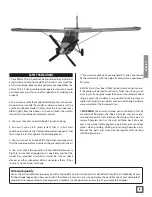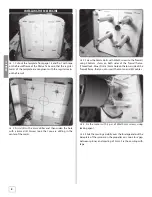
15
CHARGE THE BATTERIES
Follow the battery charging instructions that came with your
radio control system to charge the batteries. You should always
charge your transmitter and receiver batteries the night before
you go flying and at other times as recommended by the radio
manufacturer.
NOTE:
Checking the condition of your receiver battery pack is
highly recommended
. All battery packs, whether it's a trusty
pack you've just taken out of another model, or a new battery
pack you just purchased, should be cycled, noting the discharge
capacity. Oftentimes, a weak battery pack can be identified
(and a valuable model saved!) by comparing its actual capacity
to its rated capacity. Refer to the instructions and recommen-
dations that come with your cycler. If you don't own a battery
cycler, perhaps you can have a friend cycle your pack and note
the capacity for you. gemessenen. Hier können große Unter-
schiede auftreten.
BALANCE PROPELLERS
Carefully balance your propeller and spare propellers before
you fly. An unbalanced prop can be the single most significant
cause of vibration that can damage your model. Not only will
engine mounting screws and bolts loosen, possibly with
disastrous effect, but vibration may also damage your radio
receiver and battery. Vibration can also cause your fuel to
foam, which will, in turn, cause your engine to run hot or quit
We use a Top Flite® Precision Magnetic Prop Balancer™
(TOPQ5700) in the workshop and keep a Great Planes Finger-
tip Prop Balancer (GPMQ5000) in our flight box.
GROUND CHECK
Before flight inspect the model to make sure all screws remai-
ned tight, the hinges are secure, the prop is secure and all
pushrods and connectors are secure. Also check the landing
gear after every flight.
RANGE CHECK
Ground check the operational range of your radio before the
first flight of the day. With the transmitter antenna collapsed
and the receiver and transmitter on, you should be able to
walk at least 100 feet away from the model and still have
control. Have an assistant stand by your model and, while
you work the controls, tell you what the control surfaces are
doing. Repeat this test with the engine running at various
speeds with an assistant holding the model, using hand sig-
nals to show you what is happening. If the control surfaces
do not respond correctly, do not fly! Find and correct the pro-
blem first. Look for loose servo connections or broken wires,
corroded wires on old servo connectors, poor solder joints in
your battery pack or a defective cell, or a damaged receiver
crystal from a previous crash.
ENGINE SAFETY PRECAUTIONS
Failure to follow these safety precautions may result
in severe injury to yourself and others.
❍
Adjust the fail safe of your radio system so, that on signal
lost the motor is powered down immediately.
❍
Program a motor safety switch on your transmitter, if
possible.
❍
Do not run the engine in an area of loose gravel or sand;
the propeller may throw such material in your face or
eyes.
❍
Keep your face and body as well as all spectators away
from the plane of rotation of the propeller as you start
and run the engine.
❍
Keep these items away from the prop: loose clothing,
shirt sleeves, ties, scarfs, long hair or loose objects such as
pencils or screwdrivers that may fall out of shirt or jacket
pockets into the prop.
❍
The engine can be hot after use. Do not touch after
operation.
❍
After flight bring the plane in a safe position
ENGLISH


































